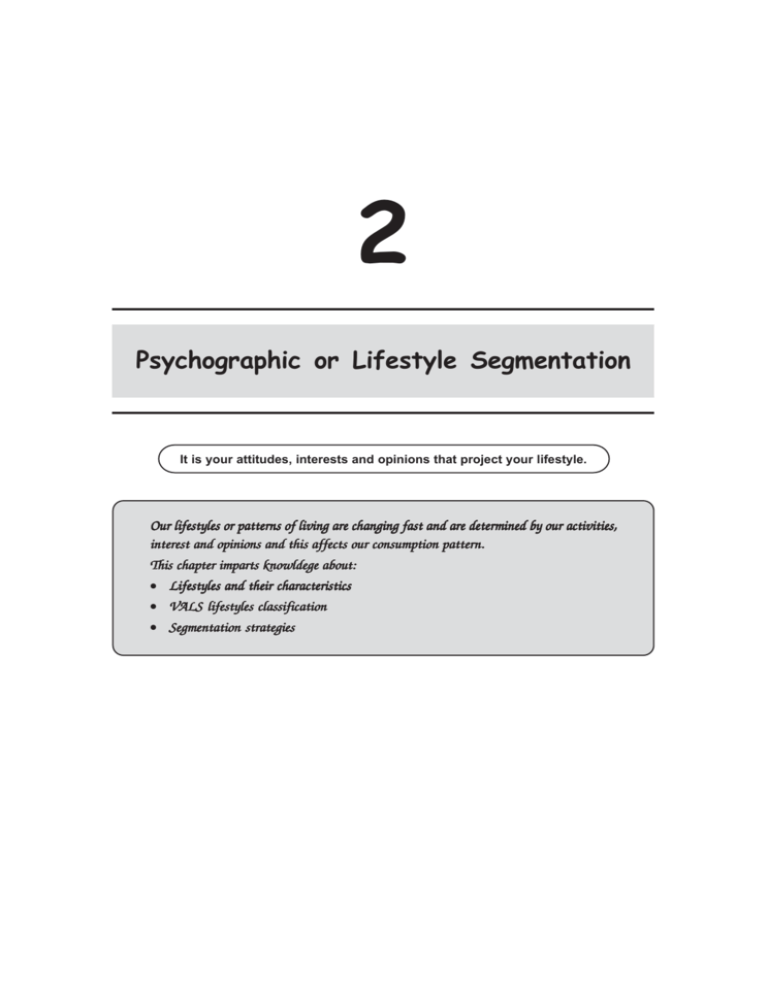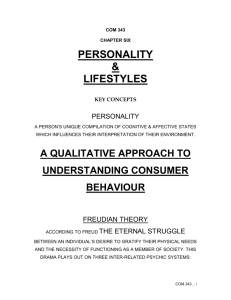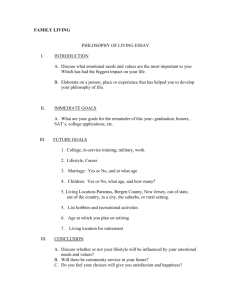Psychographic or Lifestyle Segmentation - E-Book
advertisement

2 Psychographic or Lifestyle Segmentation It is your attitudes, interests and opinions that project your lifestyle. Our lifestyles or patterns of living are changing fast and are determined by our activities, interest and opinions and this affects our consumption pattern. This chapter imparts knowldege about: • Lifestyles and their characteristics • VALS lifestyles classification • Segmentation strategies CHAPTER 2 Psychographic or Lifestyle Segmentation 2.1 Introduction It is defined simply as how one lives, and spends money. It is determined by our past experiences, innate characteristics and current situations. The products we consume are related to our lifestyle. Lifestyle marketing established a relationship between the products offered in the market and targeted lifestyle groups. Lifestyles segmentation is based on activities and interest and opinions of groups. These are psychographic segmentations, and lifestyles are derived from psychographics. Lifestyle is a unified pattern of behaviour that determines consumption and, is also in turn determined by it. Demographic and psychographic lifestyles are complimentary and work best together. Demographic variables help marketeers “locate” the target market, and psychographics provides more insight into the segment by taking into their activities interests and opinions. An idea of AIO studies is provided in Table 2.1: Table 2.1 Activities Interest Opinions Demographics Work Family Themselves Age Hobbies Home Social issues Education Social events Job Politics Income Vacation Community Business Occupation Entertainment Recreation Economics Family size Club member Fashion Education Geography Community Food Products City size Shopping Media Future Life cycle Sports Achievements Culture Dwelling Source: Joseph T. Plummer–The concept application of lifestyle dimensions Journal of Marketing. Activities: Activities can be described as how one spends his time. Interests: Interests are a person’s priorities and preferences. Opinions: It is how one feels about a wide variety of events. 18 19 PSYCHOGRAPHIC OR LIFESTYLE SEGMENTATION Marketeers try to find out the activities, interests, and opinions of people by questions to be answered on a rating scale. This is done to find out how strongly one agrees or disagrees with the question. Characteristics of Lifestyle 1. Lifestyle is a group phenomenon which influences others in the society. A person having a particular lifestyle can influence others in a social group. 2. Lifestyle influences all areas of one’s activities. A person having a certain lifestyle shows consistency of behaviour in other areas as well. You can always predict that a person shopping from elite or speciality stores, would not shop from common places. The same applies to eating habits and other habits as well. 3. Lifestyle implies a central life interest: A person may have interest in education, leisure, adventure work, sexual exploits, etc. which any become their main interest in life. 4. Social changes in society affect lifestyles: For example, as the society becomes more affluent, lifestyles of people change, sometimes drastically. As one would become richer ones lifestyle changes accordingly. Lifestyle Segmentation This is known as value and lifestyle segmentation and was introduced in 1978 by Arnold Mitchell. It provides a systematic classification of American adults into nine segments. These (Middle or upper income) Outer directed Enjoy good life Brand cautious Lifestyle directed by external criteria Need-driven (poor and uneducated) Group regarded as most advanced in techniques and ideas Fully mature integrated Buy hitech achiever make things happen Value for money Simple frugal person Reads labels carefully Societally conscious Upwardly mobile and status conscious emulator buy to impress Pursue a rich and inner life experimental for experimenting Conventional conservative and unexperimental belonger Avant garde I am me go after fads typically young given to whims N-ADVER\AD2-1.PM5 People motivated by inner needs Brand loyal careful shoppers go for popularity of the product Sustainer Motivation is by brand name and guarantees impulse buyers Survivor Motivation is price dominant Not very knowledgeable Fig. 2.1 Values and lifestyle segments (VALS) DHARM Inner directed Combination of outer and inner directed 20 CONSUMER BEHAVIOUR were widely used. Despite its popularity, some managers felt that the nine segments given by VALS are not appropriate, as two of the segments cover one-third of the entire population, leaving the rest to be divided into 7 segments, which become too small to be of interest to many firms. These nine segments are shown in Fig. 2.1. The figure shows four major groups or classfication: (a) Need driven: (poor and uneducated). (b) Outer directed: (middle or upper income class consumer whose lifestyle is directed by external criteria). (c) Inner directed: (people motivated by inner needs rather than by the expectation of others). (d) Integrated: (this group combines the best of outer and inner directed. They are fully matured). A further break-up of these groups is shown in the figure, and their characteristics can be described as given below: 1. Survivors: They are disadvantaged people, who are poor, depressed and withdrawn. Their purchases are price dominant, and they like to buy products which are economical and suit their pocket. They are not very knowledgeable. 2. Sustainers: They are motivated by brand names. They look for guarantee and are impulse buyers. These people are disadvantaged and want to get out of poverty. 3. Belongers: They buy products which are popular. They are careful and brand loyal shoppers. They are people who are conventional, conservative, and unexperimental. 4. Emulators: They are status conscious and upwardly mobile. They emulate others, and buy products to impress other people. They have high aspirations in life. 5. Achievers: They buy top of the line products. They are brand conscious and loyal. They are leaders and make things happen. They want to enjoy a good life. 6. I am me: These people are typically young, self engrossed and given to whims. They go after fads and do not mind taking the lead. 7. Experimentals: These people pursue a rich inner life and want to directly experience what life has to offer. 8. Societally conscious people: They are simple, frugal persons; who read labels carefully and seek information. They are conscious of society and social responsibility. They want to improve conditions in society. 9. Integrated: These are fully matured people and constitute the best of outer and inner directed. These segments did not appeal to many marketeers and therefore, VALS 2 was introduced in 1989. This system has more of a psychological base than the original, which was more activity and interest based. VALS 2 is based on attitudes and values. It is measured by 42 statements with which the respondents state a degree of agreement and disagreement. It has identified three primary self orientations: Principle oriented: They are guided by their beliefs and principles. Status oriented: These individuals are heavily influenced by actions, approval and opinion of others. Action oriented: They desire social and physical activity, variety and risk taking. DHARM N-ADVER\AD2-1.PM5 21 PSYCHOGRAPHIC OR LIFESTYLE SEGMENTATION These three orientations determine the types of goals and behaviours that consumers will pursue, and the goods they will get interested in. VALS 2 segments, consists of eight general psychographic segments as shown in Fig. 2.2. This classification is based on Maslow’s hierarchy of needs. At the bottom are the people with minimal resources and, on the top we have people with abundant resources. This divides the consumer into 3 general groups or segments. Each of these segments have a distinctive lifestyle, attitude and decision-making. The figure shows their characteristics as wel. The eight segments also differ in their resources and orientations. The resources possessed by those at the bottom are very little and as we move upwards the resources increase. Besides money and physical resources, people at the bottom lack in education, social resources, psychological resources and in self confidence. These studies were made on American people. The demographic characteristics like, age, income, occupation, role, religion, sex education, marital status can easily be identified. However, it is more difficult to identify psychographic characteristics of attitudes, beliefs, interests, benefits, lifestyle, etc. This can be done by VALS segmentation. Abundant resources Actualizer Principle Status Action Fulfilled Achiever Experiencer Believer Striver Maker Minimal resources Struggler Fig. 2.2 Values and lifestyle segments (VALS) For a segment to be worthwhile, it must have a proper size, i.e., enough number of people in the segment to make it feasible. It must be stable, so that the people belonging to a segment not only remain there, but the segment must also grow in size. The segment must also be accessible, so that the marketeer is able to reach the segment in an economical way. They can be reached through various media. Marketeers also are on the lookout for new media that can reach the audience with minimum waste, circulation and competition. The segment should be such that profits can be gained. By catering to a segment, profits must be ensured. Profits are the backbone of any organisation. The target segment has to be profitable. DHARM N-ADVER\AD2-1.PM5 22 CONSUMER BEHAVIOUR Strugglers These are poor people, struggling for existence. Education is low, low skilled, without strong social bonds. They are despairing and, have a low status in society. Their chief concern is to fulfil their primary needs of physiological security and safety needs. They represent a modest market and are loyal to their favourite brands. Makers They are in the action-oriented category. They have construction skills and value self sufficiency. Makers experience the work by working on it. They are people engaged in construction work and work with their hands and in the industry. They are politically conservative, suspicious of new ideas, they buy stuff which helps them in achieving their purpose. They buy tools, pick up trucks and, all that helps them in practical work. Strivers They are a status-oriented category, but have a low income as they are striving to find a secure place in life. They are low in economic, social and psychological resources. They are concerned about the opinion of others. They see success with money. They like to be stylish. They wish to be upwardly mobile and strive for more. Believers They are in the principle-oriented category. They are conservative, conventional people, with their needs, strong faiths, and beliefs. Have modest resources sufficient to meet their needs. They are conservative and predictable. Use established brands. Experiencers They are action oriented, young, vital, enthusiastic, impulsive and rebellious. They have enough resources and experiment in new ventures. They indulge in exercise, sports, outdoor recreation and social activities. They are avid consumers and spend much on entertainment, clothing, food, music, videos, movies, etc. This pattern of behaviour changes, as they are enthusiastic to new ideas. Achievers They are also placed high in the Maslow’s hierarchy of needs and are career and work oriented. They make their dreams come true. They are workaholics. Work provides them with a sense of duty, material rewards and prestige. They live conventional lives, authority and image is important to them. They also favour established products and show their success around. Fulfilled As the name suggests, they are satisfied and mature people who are well educated, value order, knowledge and responsibility. They are practical consumers and conservative. They look for products which are durable, have value and function properly. They are well informed about the world, and are ready to increase their knowledge. Prefer leisure at home. Actualisers They have abundant resources and are sophisticated in their taste and habits. They are active, and have high self-esteem. They develop, explore and express themselves in a variety of ways. DHARM N-ADVER\AD2-1.PM5 PSYCHOGRAPHIC OR LIFESTYLE SEGMENTATION 23 They have taste and are leaders in business, and in government. They have wide interests and are concerned with social issues and are open to change. While designing a marketing strategy, a company can employ a concentrated marketing strategy or, a differentiated marketing strategy or, even a counter-segmentation strategy, depending on the need and requirements. Concentrated Marketing Strategy In this, there is one segment with a unique marketing mix designed for that particular segment. Differentiated Marketing Mix Each target segment receives a special designed marketing mix, that is, for each market we have a special mix consisting of product, price, promotion and place. Here we target several markets with different marketing mixes. This is called differentiated marketing. This is used by firms which are financially strong and well established in a product category and compete with other firms, that are also strong in the same product category (Soft drinks, automobiles, detergents). For a small company, concentrated marketing is a better bet. Counter Segmentation When a firm practices differentiated marketing strategy in different target markets, some segments tend to shrink, so that they do not have enough size and promise, and are not worthwhile to be worked upon separately. They are merged together or recombined for better handling. This is known as counter segmentation strategy. Lifestyle marketing is being used extensively these days for developing new products, positioning new products and, creating new product opportunity. Lifesytle research helps in selecting media, formulating media and promotional strategies, and improving retail performance. Questions 1. 2. 3. 4. 5. What is lifestyle marketing? Explain its characteristics? ExplainVALS segmentation. Why importance was given to VALS 2. Explain VALS segmentation given by Arnold Mitchell and explain the various categories. Explain VALS 2 segmentation with a diagram. Differentiate and explain concentrated marketing, differentiated marketing and counter segmentation. DHARM N-ADVER\AD2-1.PM5








